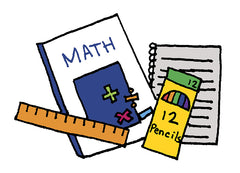Timberdoodle has often heard the question, “how do you schedule homeschooling?” and while many families do it differently we thought we would share what worked well for our family.
Our philosophy has been that the sooner a child can learn how to learn the easier homeschooling becomes. (For more on this see Why Timberdoodle Encourages Independent Learning.) So in our family growing up, as soon as we were able to read we became responsible for completing our own assignments.
Mom started each school year by figuring out how much we needed to accomplish each week in order to finish that grade level by the end of the school year. So for example: if a child had five different workbooks that year, (math, language arts, thinking skills, etc) Mom would take each workbook and divide the total pages in that book by the number of weeks we did school and that was the number of pages that we had to accomplish each week.
Example: Building Thinking Skills has 408 pages divided by 36 weeks of school equals 11.3 pages a week, which we would round up to 12 giving us a bit of slush room. After doing the math, Mom would make us a chart which we would photo copy and check off each week. (Timberdoodle now offers an online scheduler. Try out the free version of our scheduler here.)
At that point Mom bowed out of managing our homeschooling and it became our responsibility to make sure we finished each week’s assignment. If we couldn’t understand something or needed help, we would ask. But other than that Mom was hands off.

To help keep the system running smoothly we had a system of rewards and consequences in place. For our family the rule was, schoolwork must be completed by Friday evening or we missed out on Friday family movie night and were sequestered to our bedroom to keep working on the schoolwork. In case a child did not complete it all that night, all future fun activities such as playing or frivolous reading were also off limits until the child was caught up.
For a younger child the same scheduling system works well also, the only difference being that you as the parent are responsible to help them complete their list until they are old enough to be able to read the list and any instructions that may be in their workbooks.
This method is not limited to workbooks, if you have a science kit you want your child to complete you could divide up the lessons and assign the number of projects you want finished every week. Same thing goes for piano lessons, or minutes of practice etc. Simply decide how much you want done each week, draw up a check list and then turn it over to your child.
If you have group activities that you still want done together, that is not a problem. Just do it when it’s convenient for your family throughout the day. It does not need to be a part of the child’s assignments since they will not be the one primarily responsible for that activity. In our family, we wanted to read through Fallacy Detective together as a group. So we just added it to our evening reading time when we were all together anyway. Fallacy Detective was completed and we children were still responsible for the majority of our own schoolwork.
This approach takes most of the homeschooling pressure off of mom and lets mom focus on teaching the more specialized topics. Can it get much easier than that?
Precision Schedule Planning for Overachievers
In our family we never stressed over stop and start dates. If we had the flu or took a vacation, schoolwork would pick up where we left off when we returned the following week. This worked particularly well for us since we didn’t take summers off, but preferred to sprinkle the free time throughout the year anyway. My cousin however is a different story. She has four young daughters and tracks schoolwork using custom spreadsheets she designed herself! When she sat down to plan her school year she researched scheduling and holidays, then shared the information with us. (She’s amazing!)
Here are her notes for you:
Figure your Start and Finish Dates based on 36 weeks of instruction, plus the number of holidays you decide.
What might be helpful in planning your schedule:
- Public/Private School holidays, are not counted as instructional days.
- Most public school years end from 40-42 instructional weeks after it begins.
| Instruction Days/Weeks | Holidays | Total School Year | Start Date | End Date |
| 36 weeks | (4 weeks) | 40 weeks | 9-5-2012 (Wednesday after labor Day) | 06-12-2013 |
| 180 days | (25 days) | 200 days | 9-5-2012 (Wednesday after labor Day) | 06-12-2013 |
Examples of Holidays Observed in the U.S. (from Wikipedia)
Do feel free to add in your own, such as birthdays and family vacation days!
- Autumn (Fall) Break – about one week in October (in the week of Columbus Day) (some areas do not have this break, these areas only take Columbus Day itself off)
- ThanksgivingHoliday – End of November (The week of Thanksgiving – 3 days before Thanksgiving, Thanksgiving Day, and the day after – the Friday before the break is considered a half-day).
- Christmas/Holiday Break – Varies, usually starts the third Saturday in December and ends the first Monday after the New Year’s Day, unless New Year’s Day falls on a Sunday in which the first Monday is the official holiday, so school would re-open on the Tuesday after New Year’s Day, as was the case in 2012.
- Martin Luther King Break – Students have a half-day Friday and have the Weekend, Martin Luther King day, and sometimes Tuesday off.
- Winter Break – one week in February or March (depending on the region)
- Easter/Spring Break – 2 weeks in March or April (usually starting on Lazarus Saturday).
- All federal and state holidays, including religious holidays (such as Good Friday, and sometimes Jewish/Islamic holidays) – depending on school demographic.
- Teacher’s Day off (convention) – 2 to 3 days on any day in school calendar.
- Snow Days (in regions where it snows in winter) – usually a few days up to a full week allocated. Where these exceed the allocation, they are made up from scheduled breaks (such as mid-winter break), or made up with days at the end of the school year.
 Skip to content
Skip to content





